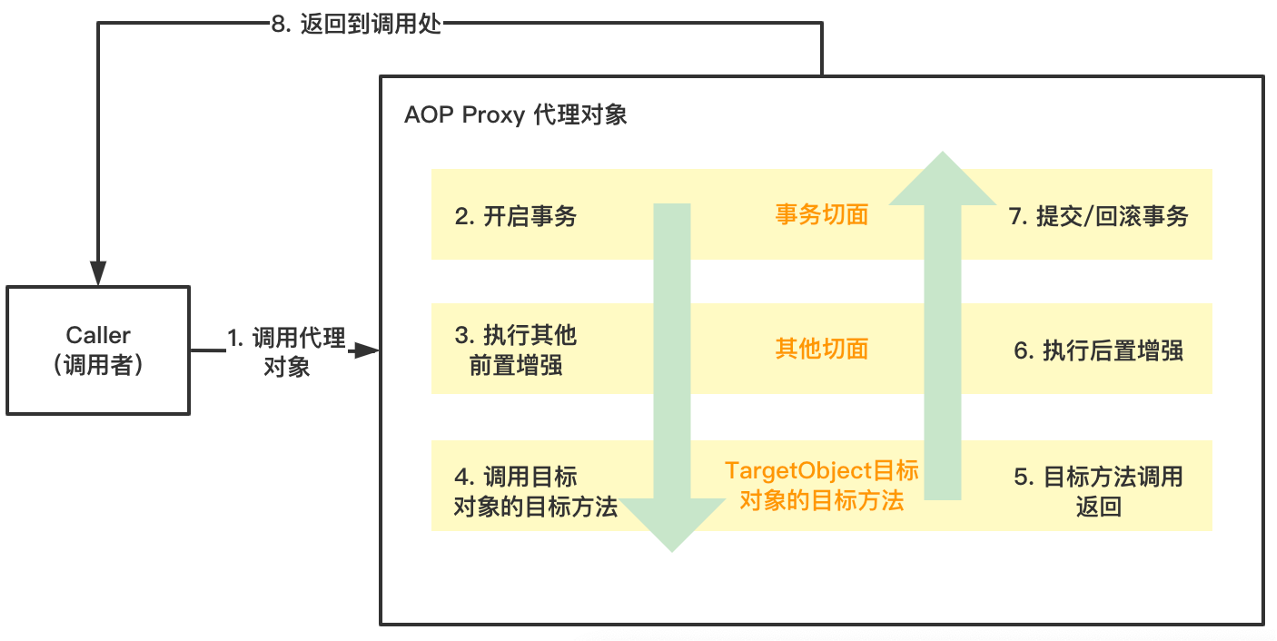本文最后更新于:August 26, 2022 pm
前言
AOP 在 Spring 项目中的使用是非常广泛的,例如日志、数据库事务、权限校验和访问控制等等场景。但是据了解对于 AOP 所实现的功能,在特定场景下会发生失效:
在同一个类中,调用使用注解方式的AOP功能的方法,目标方法的注解则会失效,即无法实现预期的功能控制,例如事务、权限等。
AOP 方法作用原理

在项目中正常情况下,调用的对象是AOP代理的对象,而非实际的目标对象或者操作实例对象。 但是在类内部的方法中,调用同一个类中定义的方法,则调用的是当前的对象,而不是代理对象,则代理失效,注解失效。
具体例子
- 自定义一个注解
@Log用于加到指定方法上记录一些信息。
| @Retention(RetentionPolicy.RUNTIME)
@Target(ElementType.METHOD)
public @interface Log {
}
|
- 然后写一个
Aspect类来进行拦截增强处理
1
2
3
4
5
6
7
8
9
10
11
12
13
14
15
16
17
18
19
20
21
22
23
24
25
26
27
28
29
30
31
32
33
34
35
36
37
38
39
40
41
42
| @Component
@Aspect
public class LogAspect {
@Pointcut("execution (* com.ac.aoptest.service..*.*(..))")
public void logPointcut() {
}
@Around("logPointcut()")
public void around(JoinPoint point) {
String methodName = point.getSignature().getName();
Object[] args = point.getArgs();
Class<?>[] argTypes = new Class[point.getArgs().length];
for (int i = 0; i < args.length; i++) {
argTypes[i] = args[i].getClass();
}
Method method = null;
try {
method = point.getTarget().getClass().getMethod(methodName, argTypes);
} catch (Exception e) {
e.printStackTrace();
}
Log log = method.getAnnotation(Log.class);
if (log != null) {
System.out.println("before:" + methodName);
}
try {
((ProceedingJoinPoint) point).proceed();
} catch (Throwable throwable) {
throwable.printStackTrace();
} finally {
if (log != null) {
System.out.println("after:" + methodName);
}
}
}
}
|
- 写一个
Service类
| @Component
public class HelloService {
@Log
public void hello(String s) {
System.out.println("\thello:" + s);
}
public void sayHello(String s) {
this.hello(s);
}
}
|
- 启动类
| @ComponentScan("com.ac")
@Configuration
@EnableAspectJAutoProxy
public class Application {
public static void main(String[] args) {
AnnotationConfigApplicationContext context = new AnnotationConfigApplicationContext(Application.class);
HelloService helloService = context.getBean(HelloService.class);
helloService.hello("world-1");
System.out.println("\n");
helloService.sayHello("world-2");
}
}
|
输出如下:
| before:hello
hello:world-1
after:hello
hello:world-2
|
可以看出sayHello方法并未被 AOP 增强。原因上述原理即可解释,因为调用到sayHello方法时使用的是原始的HelloService的实例,而不是代理的实例。所以并没有被 AOP 增强。
解决方法
1. 用 @Autowired 注入自身的实例
直接在HelloService中注入自身实例,并在sayHello方法中使用自身实例调用即可。
| @Autowired
private HelloService helloService;
public void sayHello(String s) {
helloService.hello(s);
}
|
2. 从 Spring 上下文获取增强后的实例引用
与1类似
| @Autowired
private ApplicationContext applicationContext;
public void sayHello(String s) {
applicationContext.getBean(HelloService.class).hello(s);
}
|
3. 利用 AopContext
这个方法直接获取代理实例,但是需要在主启动类入口的注解上加上@EnableAspectJAutoProxy(exporseProxy = true)。
| public void sayHello(String s) {
HelloService helloService = (HelloService) AppContext.currentProxy();
helloService.hello(s);
}
|
